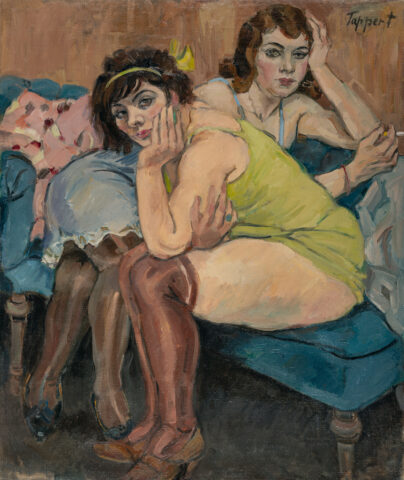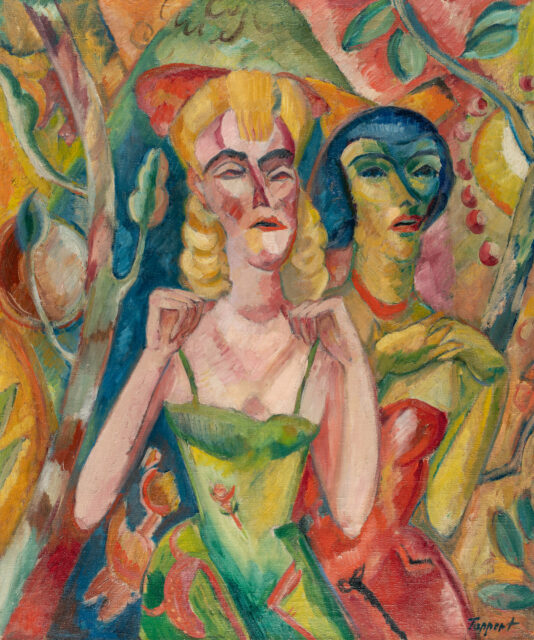
Varieté
Details
Wietek 218. Exhibitions: Große Berliner Kunstausstellung. Abteilung Novembergruppe, Landesausstellungsgebäude am Lehrter Bahnhof, Berlin 1928, cat. no.1022; Deutsche Kunst der Gegenwart, Kurhaus – Gartensaal und Wintergarten, Baden-Baden 1947; Georg Tappert. Wiederentdeckung eines Expressionisten, BAT-Haus, Hamburg 1977, cat. no.38; 15. Europäische Kunstausstellung. Tendenzen der zwanziger Jahre. Die Novembergruppe. part I: Die Maler, Kunstamt Wedding, Walther-Rathenau-Saal und Rathaus Wedding, Berlin 1977, cat. no.64, with ill. 141; Georg Tappert. Ein Berliner Expressionist, 1880 bis 1957, Berlinische Galerie, Berlin 1980/81, cat. no.31 with ill. Potsdamer Platz. Ernst Ludwig Kirchner und der Untergang Preußens, Neue Nationalgalerie, Berlin 2001, cat. no.106, with ill. 235. Provenance:Studio of des Künstlers, Berlin, verso auf dem Keilrahmen mit zwei Adressaufklebern; Kunsthandlung Gerstenberger, Chemnitz, with label on the reverse on the stretcher; collection of Peter Hopf (1937-2004), Berlin; Grisebach, Berlin 1.12.2006, lot 1650; private collection, Europe.
Descrizione
• Painted in a vivid, colourful palette of contrasting complementary tones
• Women from Berlin’s exotic twilight world were a common motif of the artist in the 1920s and 1930s
• Strong influences of Cubism and Fauvism
The fascination with the glamour of the Golden Twenties remains unbroken to this day. In the midst of extreme tensions between social opposites and the doomed young Weimar Republic, Berlin became a metropolis of enormous attraction – a cosmopolitan city in a frenzy with all its facets. The rich leisure offerings of vaudeville clubs, dance bars and cinemas characterise the nights, as do drugs and prostitution. Large sections of the population live in abject poverty and try to escape everyday life in the evening. The Kurfürstendamm becomes a boulevard and the centre of the pleasure-seeking masses. Berlin in the 1920s is the largest industrial centre in Europe and by 1929 already has over four million inhabitants. Berlin is a city that guarantees adventure, a den of iniquity, wicked and dangerous, a magnet and centre for anyone looking for fun and a stronghold of crime. A city with both a distinct upper class and an underworld, which challenged its inhabitants, frightened and fascinated them at the same time and which no creative artist of the time could ignore. Georg Tappert, born in Berlin in 1880, was one of the first German artists to discover the metropolitan world of entertainment as a pictorial theme. Growing up in Friedrichstrasse, the city’s entertainment district at the time, he came into contact with fashion and the Berlin demimonde as a child. In his work of the 1920s and 1930s, the artist mainly focussed on the women of the exotic milieu who worked in cafés, variety theatres, nightclubs and circuses. With great empathy, he shows the people of the big city in all their facets, without succumbing to the cool detachment of the New Objectivity or the socially critical verism of the time. Encouraged by the revolutionary mood of the November Group, of which he was a co-initiator in 1918, Tappert sought new stylistic means to increase his expressive power. The present painting is clearly influenced by Cubism and Futurism, with its dissection of forms into facetted sections. Using a bright and colourful palette influenced by Fauvism, Tappert depicts two vaudeville singers, one blonde and one dark-haired, heavily made up and dressed in low cut evening dresses, the stage backdrop glowing with exotic plants.
* Tutte le informazioni includono la commissione a carico dell'acquirente (27%) senza IVA e senza garanzia. Salvo errori.
** Tutte le informazioni più la commissione a carico dell'acquirente e l'IVA e senza garanzia. Salvo errori.
*** Con riserva: L'offerta è stata accettata al di sotto del limite. L'acquisizione dell'opera potrebbe essere ancora possibile nella nostra vendita post-asta.
R = Le opere d'arte regolarmente tassate
N = Opere d'arte soggette a tassazione differenziata e provenienti da un paese non UE
Non è consentita la riproduzione e la distribuzione privata o commerciale di tutte le illustrazioni delle opere esposte nell'archivio della mostra e dell'asta. Tutti i diritti riservati.


